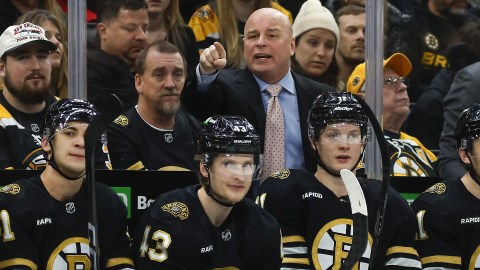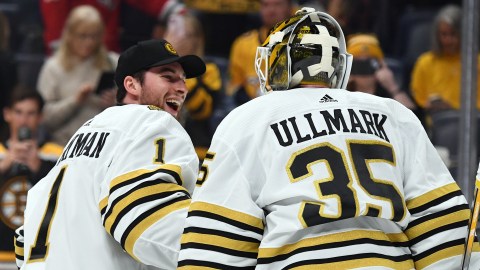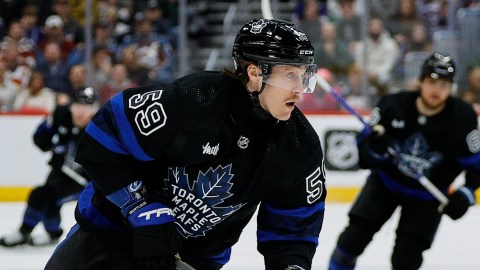Editor's note: NESN.com is running a five-part series on Shawn Thornton this week. This is Part III. Part II looked at his days in juniors.
Shawn Thornton's pro career began with what he thought was a prank call interrupting a beer run.
Thornton was used to entering drafts expecting to be overlooked. He wasn't picked the first two times he was eligible for the Ontario Hockey League draft, and only attended the draft on the third year because he planned to sign a tryout agreement once all the selections were finished. But at least he was on hand to celebrate the surprise start to his junior career when he was drafted by Peterborough.
Two years later, Thornton once again had no expectations of hearing his name called when it came time for the NHL draft. And this time he was nowhere to be found when the Toronto Maple Leafs took him in the seventh round, the 190th overall selection in the 1997 draft.
Thornton only found out he had been drafted when he happened to stop at home to pick up some beer when Maple Leafs assistant general manager Bill Watters called. Not that Thornton thought it was actually Watters on the other end of the line.
"Draft day I was golfing with my high school buddies and this is a true story, the only reason I found out I got drafted is because after golf we went back to my parents' place to pick up a case of beer," Thornton said. "The phone rang and I picked it up and the guy said, 'This is Bill Watters, is Shawn there? We just drafted you.' And I was like, 'Stop [messing] around. It's not really funny.' So he told me to hold on a second and put my agent on the phone and he told me it was real, they took me in the seventh round."
With that confusion sorted out, Thornton's long professional hockey career was set to begin. At 20 years old, he was still eligible to return to Peterborough for a third year as an over-ager, but Thornton was determined that was not going to happen.
"He worked really hard," Christine Thornton, Shawn's mother, recalled. "I remember when he got drafted, he said to his father, 'I will not be back with the Petes. I will be playing in the A.' And he did."
Wild days on the Rock
Thornton earned a spot with the Leafs' American Hockey League affiliate in St. John's, Newfoundland, but quickly found that making the squad was just the start of the battles he would face.
Hockey was a little different back in those days, especially at the minor league level. It wasn't quite Slap Shot, but there was certainly plenty of mayhem on the ice.
"It was crazy, a nightmare," Thornton said. "I had 35, 36 fights a year. It was crazy. And we had a tough team. I wasn't the only one doing it. One year I had 36 [fights], [Dennis] Maxwell had 30, D.J. Smith had like 20, Greg Smyth had 15 but he had like 350 [penalty] minutes. It was different times back then. It was just controlled chaos, and controlled is a loose term."
Fortunately for Thornton, he was on a team with plenty of toughness. That allowed him to ease into the enforcer role at the pro level a little bit, but it was still a daunting transition.
"It wasn't easy," Thornton said. "You're going from fighting guys your own age to fighting men. But I was very fortunate that we had arguably the toughest team in the league and I was just supporting cast my first year. It wasn't until my second year that I really had to step up and start taking the brunt of the responsibility. We had a really tough team my first year so it wasn't all on me, which was probably key for me having success. I think I fought only 22 times my first year, which would be a lot nowadays but back then we had a bunch of guys between 15 and 22."
Even with plenty of support when it came to dropping the gloves, Thornton still sought to establish himself at the AHL level, sometimes at the expense of the other facets of the game.
"He was a little raw as far as being a pro player," said Al MacAdam, the head coach in St. John's for Thornton's first three years there from 1997-2000. "I think he saw his role as being physical and being a fighter and I think he thought he had to play that role more often than not. As he matured as a minor leaguer I believe he discovered that he could play as well."
Thornton took his lumps at times in those early days, but he learned how to handle that as well.
"He felt he had to establish himself as a fighter in the American League, which would give him more room to play," MacAdam said. "When you're fighting at that level, a bit of ego comes into it. He had to get over the point that if a fight didn't go his way, he still felt good about himself."
Helping him feel good were his St. John's teammates, including veteran tough guys like Smyth and Clayton Norris showing him the ropes and fellow youngsters Smith, Jeff Ware, Ryan Pepperall and Donald MacLean, who became a tight-knit group toiling together in the Toronto farm system.
"We had good older guys," said Thornton, who piled up 225, 354, 316 and 320 penalty minutes in his four seasons in St. John's. "They definitely put you in your place, but it teaches you a level of respect for guys that have been around for a long time. I think that might be why I'm a little old school in that regard."
Smyth was less old school than reform school, if not insane asylum, but he was also a valued friend and teammate. Smyth racked up exactly 3,100 penalty minutes in 643 pro games in four leagues, including 783 PIMs in 228 games in the NHL.
"He was literally the craziest guy I ever played with," Thornton said of Smyth, best known in these parts as the guy who jumped out of the penalty box to challenge Lyndon Byers to Round 2 of their bout in a 1988 game between the Nordiques and the Bruins at the old Garden. "But, he'd be the first guy I'd call if I ever was in jail. He'd give the shirt off his back to help a person out if he liked you."
Smyth also indirectly helped Thornton get some extra ice time in his early pro days.
"We had Greg Smyth and he played 40 games and I think he was suspended for 40," Thornton said of one memorable season in St. John's. "So I got to play a little bit, but not that much."
The struggle to be more than just a fighter
Even with Smyth frequently banned, earning ice time was always a struggle for Thornton at the start of his pro career. MacAdam had moved him back to defense, but Thornton had a different description for the position he was playing in those days.
"Actually I was kind of the grocery stick," he explained. "I just sat in the middle of the bench. Back then you played three lines plus one and six defense[men], and I was always the plus one. If somebody went down up front I played forward. If somebody went down on the back end I played D. Not a lot of minutes played. So confidence? I had a lot of improving to do, but Al and assistant coach [Rich Brown] really helped me become a better hockey player. I had to work on my game every single day for the full two hours that practice was allotted."
Thornton dressed for almost all of the 80 games the Baby Leafs played that first year, but only played in 59.
"I literally just sat in the middle of the bench and cheer-leaded, never got a shift in those other games," Thornton said. "But it was a learning experience. Never take anything for granted."
Thornton was a willing combatant when it came time to drop the gloves, but he yearned to contribute more. Fortunately, he found a mentor in MacAdam willing to help bring the best out of him.
"You always hope that these guys can figure their game out, and he figured out how to mature as a player, how to fit in on a team and one of his attributes was always how to be a really good team player," MacAdam said. "He's a gamer. He's passionate about the game.
"When I left there after his third year I wouldn't say his game had peaked yet, but it just kept getting better," MacAdam said. "And it kept getting better as I followed his career from afar."
MacAdam was particularly impressed with Thornton's defensive play, which he utilized by moving him back to the blue line.
"He controls the puck really well when he has it," MacAdam said. "There's no giveaways. That really impressed me in St. John's with maybe the label that was on him [as a tough guy]. He's got really good poise with the puck. He puts it in places where his teammates are able to get it back and when he's on the ice, he's an asset."
It would be three years after MacAdam left St. John's before Thornton made his NHL debut and seven seasons before he became an NHL regular, but Thornton credits MacAdam for playing a major role in his development.
"He's an awesome, awesome man," said Thornton, who went from 0-3-3 totals in his first year in St. John's to 8-11-19 and 4-12-16 in his final two years under MacAdam. "He's a big part of why I'm here."
Things didn't go as well under MacAdam's successor Lou Crawford, who took over behind the St. John's bench for Thornton's final season with the Leafs in 2000-01.
"Back then I was more comfortable playing D," Thornton said. "I practiced on defense. My first three years it was pretty much all D. Then in my fourth year when Lou Crawford came in he made sure I knew I was the fourth-line right winger no matter what."
The gains Thornton had made as a player were temporarily shelved as Crawford made it clear that Thornton's primary duties were to play policeman.
"I was an assistant captain on that team and one of the leaders," said Thornton, who still finished with 5-12-17 totals and 320 PIMs that season. "He was a similar player when he played and I think he expected a lot out of me because of that. I guess it isn't a bad thing, but it was a tough year coming from the coach we had the years before. Al loved me. He was awesome. So it was different, and it was my first time going through that, so it's not all on [Crawford]. It was tough love. It was just my first time going through that, so I probably had a tougher time with it than I should have."
New home in Norfolk, and one last stop in Portland
Over a decade later, Thornton can look back with some perspective at his time under Crawford, but a fresh start was needed. That chance came when he was traded to Chicago on Sept. 30, 2001.
Thornton remained in the AHL with the Blackhawks' affiliate in Norfolk, but it was still a welcome change of scenery.
"I didn't expect to be called up," Thornton said. "I was happy to be in Norfolk, to be in a new situation and had Trent Yawney as my coach who taught me a lot about just playing the game. I was so wrapped up in who I was going to have to fight, and he got me into focusing on hockey first."
Yawney and his successor, Mike Haviland, helped Thornton continue his steady development in Norfolk between a handful of brief call-ups to Chicago between 2002-03 and 2005-06.
"I got sent down and Mike Haviland was the coach in the minors and he's probably the ultimate players' coach," Thornton said. "He put more trust in me than any coach I ever had. And our assistant coach was Rick Kowalsky, who I played against in the minors. I was first-unit power play, second line, first penalty kill. I played a lot of minutes. So the hockey, it was probably the most fun I ever had in the minors as far as playing goes because I played a ton of minutes and no one relied on me to have to take care of all the fighting."
Thornton scored 11 goals in 2002-03 and had 10-22-32 totals in 2005-06 under Haviland, but never made it up to Chicago on a full-time basis, a victim of the numbers game and losing an entire season to the owners' lockout. He signed with Anaheim in 2006 and after being sent to the Ducks' farm team in Portland, he was prepared to make that his final stop.
He didn't have to. He played just 15 games in Portland with 4-4-8 totals before finally making it up to the NHL for good with Anaheim. After 605 games, and 2,473 penalty minutes, in the AHL, Thornton had arrived, and just in time to help the Ducks capture the Stanley Cup that spring.
Coming Thursday: The series continues as Thornton finally reaches the NHL with Chicago, then becomes a regular in Anaheim and hoists the Stanley Cup for the first time.
For Part IV, click here.



